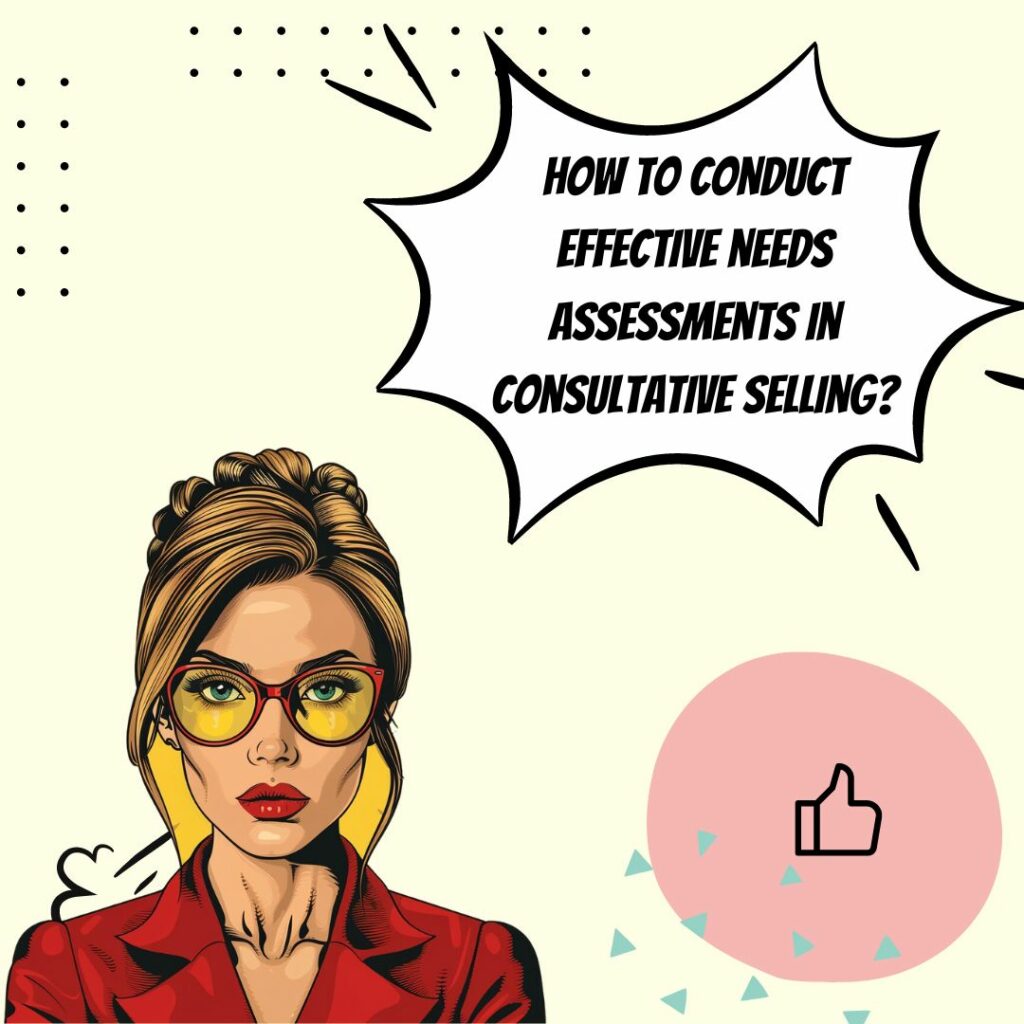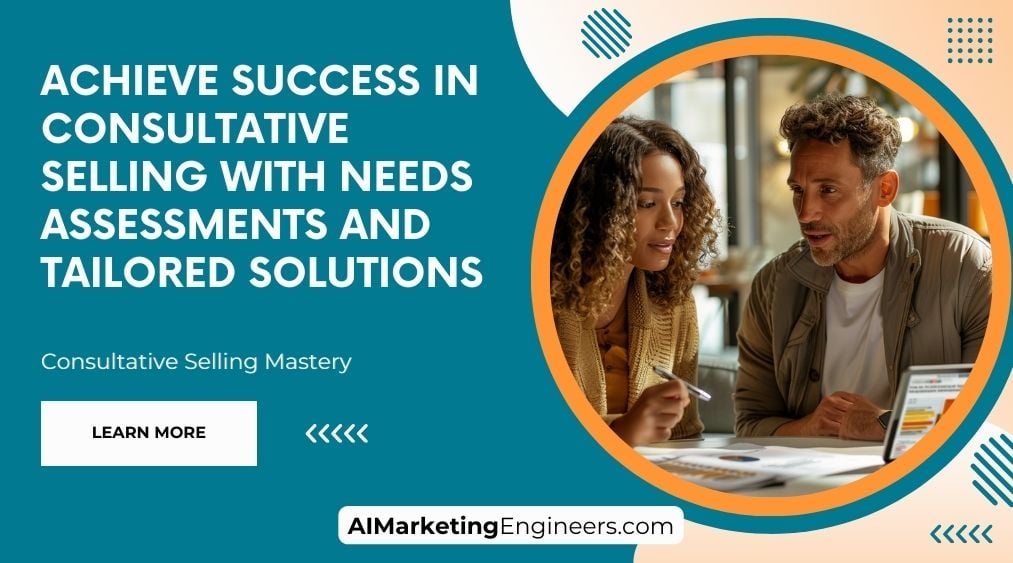Key Takeaways
✅ Conduct Thorough Needs Assessments: To excel in consultative selling, you must go beyond surface-level interactions. Dive into your customer's world using active listening and insightful questioning to unearth not just the obvious needs, but the deeper, unacknowledged ones too. Industry data shows that sales reps who prioritize customer needs see a staggering 69% more closures.
✅ Offer Personalized Solutions: Tailoring your solutions to the client's specific situation is vital. Customers are 4 times more likely to buy when offered a personalized experience. Consultative selling is not about the hard sell; it's about being a trusted advisor who guides customers towards the best decision.
✅ Build Trust and Relationships: With 81% of consumers saying that trust influences their purchasing decision, consultative selling provides more than immediate revenue; it builds a foundation for ongoing business. Cultivate authentic relationships and become the go-to source long-term by offering relevant, valuable advice without the sales pressure.

Introduction
Ever wondered why some sales professionals consistently outperform others, regardless of economic climates? The secret isn't just in their pitch; it's in their process. By mastering the fine art of consultative selling, these savvy individuals ensure they don't just meet sales targets; they build relationships that thrive over time. Consultative selling, with its root firmly planted in understanding and addressing customer needs through needs assessments and solution-based strategies, isn't just a technique—it's a mindset.
In this comprehensive exploration, we'll unveil the importance of comprehensive needs assessments and how they can transform interactions into opportunities for growth. You'll discover how customized solutions not only solve problems but also cultivate credibility and trust between you and your clients. From there, we'll look at how solid relationships serve as the cornerstone of enduring sales success.
Suspend any disbelief you might hold about traditional sales methods. We're about to take you through a journey that promises a wealth of actionable insights and groundbreaking methods to not just increase your revenue, but to revolutionize your perspective on the sales process. Get ready to harness the power of consultative selling, where every conversation can lead to a closed deal and a satisfied customer.
Top Statistics
| Statistic | Insight |
|---|---|
| 89% of buyers view reps as consultative sellers: A striking majority of buyers perceive sales representatives as advisors rather than just sellers. (Market Trends) | Consultative selling is widely perceived as the norm, which means businesses that fail to adopt this approach may be at a disadvantage. |
| 87% of new sales training is forgotten within a month: Crucial information from sales training dissipates quickly. (Market Trends) | This statistic highlights the need for ongoing training and support to ensure sales teams retain and apply their knowledge effectively. |
| 78% of business buyers seek trusted advisors: Buyers are looking for sales reps that can add real value beyond the product. (Market Trends) | Building trust and acting as a resource for customers is crucial for long-term business relationships. |
| 81% value brand trust in their purchasing decisions: Trust in a brand's integrity and actions greatly influences buyers. (User Demographics) | Emphasizes the importance of brand reputation and ethical business practises in driving sales. |
| Keeping current customers is 5 times less expensive than finding new ones: Customer retention is much more cost-effective. (Industry Forecasts) | Highlights the financial benefits of consultative selling techniques in maintaining and nurturing existing customer relationships. |
Mastering Consultative Selling: The Path to Success
Have you heard the term consultative selling and wondered what sets it apart from the typical sales approach? Well, it's like having a personal guide in the world of sales – one who takes the time to understand you and your needs before ever suggesting a product or service. It's about forming authentic relationships with customers, which not only makes them feel valued but can lead to heartfelt recommendations and repeat business. This is a powerful tool for achieving long-term sales growth because when customers feel that you have their best interests at heart, their satisfaction and loyalty tend to sky-rocket. Moreover, consultative selling encourages repeat business and referrals. It also establishes you as a trusted advisor rather than just a salesperson. Ultimately, it enhances the overall customer experience and drives sustainable business growth.
The Crucial Role of Needs Assessments in Consultative Selling
If you're looking to master consultative selling, get ready to put on your detective hat! A needs assessment is the magnifying glass through which a salesperson can examine a customer's situation and figure out what they're really looking for. This isn't about pushing a product; it's about understanding those pain points that keep the customer up at night and finding ways to ease them. By doing so, you identify customer needs, setting the stage to tailor a solution that fits like a glove. Proper needs assessments are foundational in consultative selling because they shift the focus from making a quick sale to nurturing a valuable partnership. This process builds deeper customer trust and engagement. It also helps in uncovering opportunities for cross-selling and upselling. A thorough needs assessment can differentiate you from competitors who may only offer generic solutions.
Best Practices for Conducting Effective Needs Assessments
To conduct a shining needs assessment, you'll want to embrace practices like active listening and open-ended questioning. It's akin to piecing together a puzzle – each bit of information you gather adds to the overall picture of your customer's needs. Paying keen attention to their answers and asking for elaborations where necessary can unearth gems of insight that a purely transactional approach often misses. To top it off, it's crucial to analyze the collected data to ensure that your findings are as accurate as a finely tuned watch. Beware of common obstacles like personal biases or assumptions, and strive to maintain an objective stance – it'll pay dividends when developing customer solutions. Documenting your findings systematically can help in future reference and follow-ups. Regularly revisiting and updating the assessment ensures it remains relevant and useful. Training in empathetic communication can enhance your ability to conduct effective needs assessments.
Crafting Solutions That Perfectly Meet Customer Needs
Now comes the creative part: developing solutions that hit the bullseye of your customer's needs. With the information from your assessments in hand, you can start crafting those customized solutions that show your customers how much you 'get' them. This is where collaboration and innovation take center stage, as you need to think outside the box and maybe even work with others to put together something truly unique. The payoff is a solution that not only fits the need but also wows the customer with its tailored precision. Tailoring solutions also helps in building stronger client relationships. It demonstrates your commitment to addressing specific needs. Regularly seeking customer feedback can further refine your offerings and ensure they stay aligned with customer expectations.
Presenting Solutions and Building Trust with Clients
When it's showtime, your goal is to present your solution in such a compelling way that the client feels you've handed them the key to their own treasure chest. Clear and persuasive communication here is essential. Handling any objections skillfully and demonstrating the value proposition of what you're offering can make all the shammy and shine of other sales pitches pale in comparison. It's about showing, not just telling, the customer that they can trust you to have their best interests at heart. Building trust involves being transparent and honest in your presentation. Using case studies and testimonials can bolster your credibility. Ensuring follow-up and consistent communication reinforces the trust you've built.
Measuring Success and Striving for Continuous Improvement
Every good business strategy needs a scorecard, and consultative selling is no different. Measuring success isn't just about how much you've sold but also about customer feedback and satisfaction. Do they feel heard, understood, and valued? It's about looking at metrics that make sense and using them to refine your process. Continuous improvement means taking that feedback, positive or negative, and turning it into a better approach, more accurate needs assessments, and even more effective solutions. In the ever-evolving landscape of sales, this cycle of reflection and refinement is crucial for staying ahead of the curb. Implementing a system for regular performance reviews can highlight areas for improvement. Encouraging a culture of feedback within the sales team can drive innovation and growth. Keeping abreast of industry trends and adapting your approach ensures ongoing success.
AI Marketing Engineers Recommendation
Recommendation 1: Leverage Behavioral Data to Enhance: Utilize customer behavior analytics to gather data on how potential clients interact with your product or services online. For instance, look at how long they spend on specific pages, what content they engage with, and at which point they exit your website. Did you know that according to a study by Salesforce, 89% of business buyers expect companies to understand their business needs and expectations? By using this behavioral data, sales professionals can tailor their needs assessments to each unique client, ensuring the solutions offered resonate more effectively.
Recommendation 2: Integrate Social Listening into Your Strategy: Tap into social media platforms to monitor conversations around the challenges and needs within your industry. By applying social listening tools, businesses can pick up on the pain points and desires of their target audience without direct dialogue. Keeping an ear to the ground can help tailor the needs assessment process. This is especially pertinent when we consider that 54% of social browsers use social media to research products (GlobalWebIndex). By staying ahead of the trend curve, consultants can present solutions that clients may not even have realized they need yet.
Recommendation 3: Employ CRM Solutions to Streamline: Invest in a robust Customer Relationship Management (CRM) software to maintain comprehensive records of customer interactions, preferences, feedback, and transaction history. A report by Grand View Research stated that the CRM market size was valued at USD 52.64 billion in 2021 and is expected to expand at a compound annual growth rate (CAGR) of 10.6% from 2022 to 2030. CRM systems offer a treasure trove of data that can inform more personalized needs assessments and solution offerings. The ability to track and analyze customer data all in one place is invaluable for any consultative selling approach, ensuring that recommendations are accurate, timely, and highly relevant.
Relevant Links
- Consultative Selling Techniques: Beyond the Sales Pitch.
- Identify True Customer Needs
- Active Listening is Your Sales Superpower.
- Customized Solutions with a Consultative Approach.
- Win Clients for Life with a Trust-Based Consultative Approach.
Conclusion
In the realm of sales, the path to success is often paved with a deep understanding of your customers' world. Consultative selling stands as a beacon for those looking to foster meaningful connections and drive growth, not by pushing products, but by solving real problems. It’s about moving beyond the sales pitch and into the territory of genuine service. So, what does this insight mean for you and your team?
Every effective consultative selling process begins with a keen needs assessment; it's the cornerstone that allows sales professionals to pinpoint customers' pain points and aspirations. By embracing practices such as active listening and open-ended questioning, one can unearth the invaluable details that inform tailored solutions. And let me tell you, in today's world, customers can sniff out inauthenticity a mile away – they yearn for solutions sculpted just for them.
Characterized by collaboration and innovation, the solutions developed through consultative selling are not just products or services; they are bridges building trust between people. This approach is a testament to not just meeting needs but truly understanding them. By measuring success and seeking continuous improvement, businesses can turn consultative selling into both an art and a science. In a market that's brimming with options, why should a customer choose you? Because you’re not just selling – you’re enriching their lives in a tangible way. The article highlighted that cementing trust through presenting solutions is paramount, and doing so effectively can transform once-off transactions into lasting partnerships.
If we've learned anything, it’s that being a trusted advisor to your customers speaks volumes compared to being just another vendor. So, as you reflect on the strategies shared, ask yourself: Are you ready to delve into the depths of your customers' needs to offer them not just what they want, but what will truly drive their success forward? Consultative selling isn't just a strategy; it's the future of meaningful business relationships.
FAQs
Question 1: What is consultative selling?
Answer: Consultative selling is a sales approach where you act almost like a trusted advisor. You get to know the client, understand what they really need, and come up with recommendations that can make things better for them. It's all about building a bond, really digging into what the client wants, and then pointing them towards solutions that fit just right.
Question 2: What are the key principles of consultative selling?
Answer: The important bits are all about the art of the conversation. Ask smart questions, listen like you mean it, keep it real - no fake smiles or empty promises - and make sure you're solving the client's problems, not just pushing a product on them.
Question 3: How does consultative selling differ from solution selling?
Answer: Pretty simple, really. Consultative selling is about the big picture, where you get into the client's shoes and figure out their expectations and needs. Solution selling? That's more like, "Hey, I've got something to sell. Do you want to buy?" It's all about the seller's stuff, not so much the buyer's needs.
Question 4: What are the essential skills needed for effective consultative selling?
Answer: Think of it as staying sharp. You need to know the client's field almost as well as they do, always learning new things, and be ready to share some clever insights and tips. Knowledge is power, and power in sales means helping clients look smart and get ahead.
Question 5: How do you identify unique pain points and provide customized solutions?
Answer: Start by chatting and asking questions that get them thinking deeper, not just about what's bugging them today, but why it's a headache in the first place. It's less about the symptoms and more about finding the cause, so you can swoop in with the perfect remedy.
Question 6: How do you build strong relationships with clients using a consultative sales approach?
Answer: It's all in the talk. Have conversations that matter, show them you're in their corner, and hand out advice and solutions that fit like a glove. Be the go-to person when they're scratching their heads, and you'll be more than just a salesperson—you'll be a partner.
Question 7: What are some effective consultative sales questions?
Answer: You might ask:
- How have the bumps in the road this past year messed with your business?
- What's the ripple effect of those issues on your earnings or team spirit?
- Is there something that's perfect just the way it is?
- What's a win in your book when it comes to your current suppliers?
- How fast are you looking to move on this decision?
- What's the money ballpark you're playing in?
- Seen anything lately that really caught your eye?
- Walk me through how you nail down these kinds of decisions.
- Who's in the decision-making gang, besides you?
- If you had a magic wand, what would you change about your situation?
- What's the one thing that tops your list for this decision?
- Imagine we fix your problem—what's the good word for your business?
- What does fixing this problem mean for you, personally?
Question 8: How do you prepare for a consultative sales presentation?
Answer: Do your homework. Learn all about the client's line of work, their company, the stuff they're currently using, and jazz up your presentation with things they actually care about.
Question 9: How do you track your consultative selling skills?
Answer: Get techy with call analytics and tracking tools. Listen back to how you handle your sales chats, tweak your questioning style, and refine how you talk about the benefits you're offering.
Question 10: What are some common mistakes to avoid in consultative selling?
Answer: Steer clear from rattling off a list of questions, asking stuff that leads them down a specific path, and getting caught in a bad conversational groove. Instead, keep it open-ended, listen more than you talk, and earn their trust by being genuine.
Academic References
- Richardson Sales Performance. Understanding Customer Needs in Consultative Selling. This reference offers insight into consultative selling, emphasizing the importance of genuinely understanding customer needs through a process driven by curiosity and targeted questioning. The goal is to learn about the client's challenges and objectives to tailor solutions that address these specific issues.
- HubSpot. The Consultative Selling Process. HubSpot outlines a strategic framework for consultative selling that includes comprehensive research, engaging in active listening, adeptly diagnosing issues, and educating potential clients on solutions that are customized to their particular needs, focusing primarily on the outcomes and added value for the customer.
- The Sales Blog. Consultative Selling: Identifying Client Needs. This source details strategies used by consultative sales professionals to uncover areas where a client may lack information or solutions. By deploying incisive questions and showcasing their expertise, salespeople can position themselves as authoritative figures and guide the client to beneficial choices.
- Maguire Training. 7 Secrets of Successful Consultative Salespeople. This resource provides insights into the traits and practices of effectively consultative salespeople who act akin to consultants. It emphasizes the importance of establishing trust, conducting diligent customer research, and utilizing proficient questioning and listening skills to suggest appropriate and personalized solutions.
- Zendesk. 4 Principles of the Consultative Sales Approach. Zendesk highlights four tenets of consultative selling: authenticity in interactions, a solution-oriented mindset, a genuine wish to assist prospects, and the importance of adding value while nurturing robust relationships with customers.












